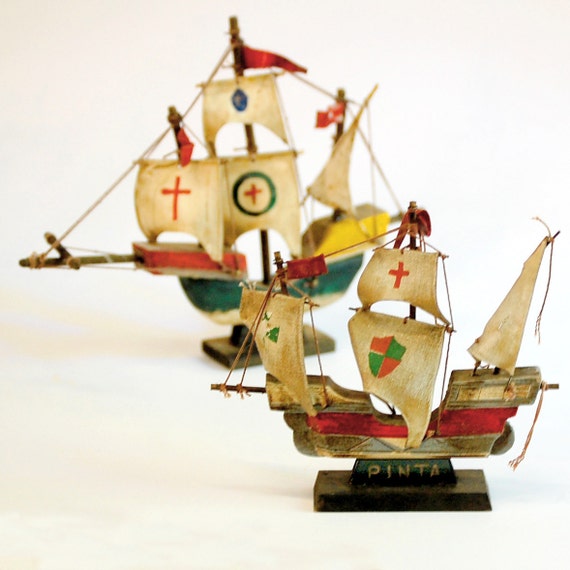
The exact measurements of length and width of the three ships have not survived, but good estimates of their burden capacity can be judged from contemporary anecdotes written down by one or more of Columbus's crew members, and contemporary Spanish and Portuguese shipwrecks from the late 15th and early 16th centuries which are comparable in size to that of Santa María. Niña, Pinta, and the Santa María were modest-sized merchant vessels comparable in size to a modern cruising yacht. All these ships were second-hand (if not third- or more) and were not intended for exploration. The other ships of the Columbus expedition were the smaller caravel-type ships Santa Clara one particular ship sailed for 46 years and was remembered as La Niña (" The Girl"), and La Pinta (" The Painted"). Santa María had a single deck and three small masts. Santa María was probably a medium-sized nau ( carrack), about 58 ft (17.7 m) long on deck, and according to Juan Escalante de Mendoza in 1575, Santa Maria was " very little larger than 100 toneladas" (about 100 tons, or tuns) burthen, or burden, and was used as the flagship for the expedition. Santa María was built in Pontevedra, Galicia, in Spain's North-West region. Her master and owner was Juan de la Cosa. La Santa María de la Inmaculada Concepción ( Spanish for: The Holy Mary of the Immaculate Conception), or La Santa María, originally La Gallega, was the largest of the three ships used by Christopher Columbus in his first voyage across the Atlantic Ocean in 1492. Immaculate Conception of the Blessed Virgin MaryĬhristopher Columbus on Santa María in 1492, oil Colombo monument One of Santa María 's alleged anchors on display at Musée du Panthéon National Haïtien Ship model at Fort San Cristóbal, San Juan, Puerto Rico Santa María de la Inmaculada Concepción (originally La Gallega) This was an active civilization until we were inflicted. "This wasn't a lost-and-found hemisphere. "It's a celebration of ignorance and arrogance," said Suzan Shown Harjo, national coordinator of the 1992 Alliance, a coalition of Indian groups. American Indian groups complain Columbus' arrival in the Americas began a process that led to the destruction of much of Indian civilization. Not everyone is happy with the attention the ships are generating. Tens of thousands of South Floridians, including schoolchildren from Broward, Dade and Palm Beach counties, are expected to tour the ships during their two-week stay. "After the first time, it all seemed natural. Rough seas once rolled the ship more than 45 degrees. In Santo Domingo, Santa Maria crewman Antonio Toledo, 24, said the Atlantic passage was sometimes harrowing. They also have visited Santo Domingo, Dominican Republic, and the Bahamian island of San Salvador, possibly Columbus' original landing site. The replicas were christened in 1990 and embarked on a 10-month tour of Europe, visiting ports in Spain, France, Italy and Portugal. As they needed food, they would slaughter an animal," he said. "Nobody would sleep downstairs because of the smell. The Nina, being the smallest, was used to explore shallow waters, the Pinta was a fighting ship, and the Santa Maria stored livestock in its hold. The original ships were built for three purposes, Caspari said. The ships carry modern navigational instruments and have diesel engines. The sleeping quarters are taller with more headroom, and crew members sleep on bunks and eat refrigerated food. The replicas offer more comfort for the 52 Spanish crew members than the originals. They are really constructed to withstand abuse anticipated out there on the ocean," said quincentennial committee member Peter Caspari. "They are much sturdier than we originally thought. Hemp was used to caulk the ships' bottoms and decks. The sails are made of linen, the closest natural fiber to hemp canvas.

The hand-forged nails were modeled after some recovered from a 16th century shipwreck.

The hulls were fashioned from pine and oak taken from the forests of Galicia in northwestern Spain and the Pyrenees, the mountains separating Spain and France. The wooden replicas, commissioned by Spain, were constructed with the same materials carpenters used in 1492. "Now the replicas are discovering Miami." territory to where Columbus really landed," he said, estimating 250,000 people would watch the ships' arrival.


 0 kommentar(er)
0 kommentar(er)
